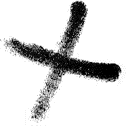 |
By the sweat of your brow you will eat your food until you return to the ground, since from it you were taken; for dust you are and to dust you will return. (Genesis 3:19)
Covering ones head with ashes is part of the ancient Biblical tradition of mourning. On Ash Wednesday, Roman Catholic, Anglican, and some other churches hold special services at which worshippers are marked with ashes, a sign of penitence and mortality that heralds the beginning of Lent.
Palm Sunday—observed the Sunday before Easter—is a remembrance of Jesus’ triumphant entry into Jerusalem. Crosses made of palm rushes are blessed, and later burnt, the ashes a reminder of the crucifixion that followed. However the circle of hope and belief is completed the following year, when these same ashes are used to mark believers’ forehead, an affirmation for Christians that, through Christ’s death and resurrection, all believers can be free from sin.
In
some churches, worshippers keep the mark of ashes, thus carrying the sign
of the cross out into the world; in others the service ends with the mark
being removed, a sign that the participants have now been cleansed of
their sins.